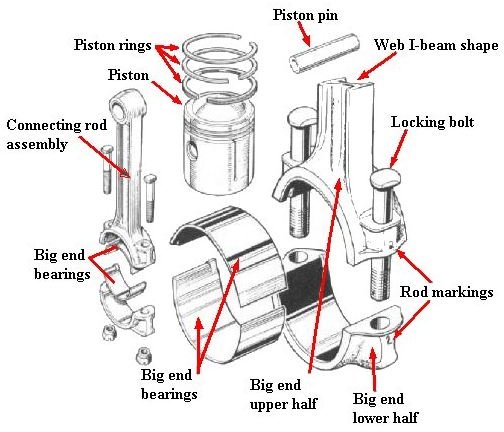Connecting Rod Bolts
Bottom End Bolts, Particularly in Medium Speed Engines, are Prone to Failure under Normal Conditions
Connecting rod bottom end bolts keep the two halves of the bottom end bearing together. These bolts are subjected to complex nature of stress as follows:
Tensile Stress: Tightening of nuts stretches the bolts and subjects them to tensile stress, which helps keep the two components together under tension compression.
Fluctuating Tensile Stress: The tensile stress set in the bolt while tightening is of higher degree to reduce fluctuating stress in modern highly rated engines.
In 4-stroke engines, at the end of exhaust stroke the inertial load is acting upwards. As a result, the piston has a tendency to fly out. Therefore, momentary load reversal takes place in the bearings. At this period, the load is on the top-half of the main bearing, the bottom half of the bottom end bearing, and the top half of top end bearing- which is just opposite to normal load condition. This load reversal continues at every cycle.
This is the significant effect on bottom end bolts, because the whole connecting rod is under tension at the stage of load reversal. Therefore the bottom end bolt is subjected to additional tensile stress at the end of the exhaust stroke, resulting in severe stress fluctuations during the cycle.
Shear Stress: The two halves of the bottom end of the connecting rod have a tendency to pull apart. This results in shear stress in the bolt keeping the two parts together.
Bending Stress: Bending stress of a fluctuating nature also takes place while the bottom end is distorting. During the power stroke, the bolt bends outward and during the exhaust stroke the bolt tends to bend inward.
As these fluctuating stresses lead to the fatigue failure of bottom end bolts, and this is why the bottom end bolts are prone to failure under normal condition in medium speed engines.
Connecting Rod With its Parts
Minimizing the Failure of Connecting Rod Bolts by Proper Maintenance
The following proper maintenance can minimize bolt failure:
1. Proper Surface Finish: The bolt is given a good surface finish to reduce stress raisers. Bolt surface and threads must not be damaged by rough handling.
2. Proper Tightening:
- Bolts should be tightened according to the manufacturer’s instructions. A high degree of penetration is given during tightening to keep the fluctuation of stress low.
- Tightening must be done in stages.
- One should not flog the bolt with the hammer in the direction of tightening.
- The landing faces of the bolt-head nut should be cleaned.
- During tightening, measurement of the extension is essential for correct stretch.
- Always change the bolts in pairs.
3. Apply proper lubricant on the head during tightening according to the manufacturer’s instructions. If the lubricant used has lower viscosity than recommended and nuts are tightened to recommended torque, the bolts will be, in fact, left a little slack. On the other hand, using a higher viscosity lubricant induces additional bending stresses.
4. Check the bolt for cracks, damage, etc.
5. Sounding testing by hammer to identify internal flaws and cracks. It should be healthy noise.
6. Locking of the nuts should be checked thoroughly.
During inspection it is identified that the bolt locking is intact, but the bolt is actually loose.
- The bolt locking being intact indicates that the nut is displaced from the tightening position. As the bolt is loose, it indicates that the bolt has been permanently deformed. This happens mainly due to over-tightening of the bolt.
- In 4-stroke engines the load reversal at the end of exhaust stroke has significant effect on the connecting rod bolts. At this stage the bolt is subjected to additional stress because the entire connecting rod is under tension. If the bolt is given a higher pretension than recommended, then the additional tensile stress plus the pre-stress may be high enough to lead the bolt to plastic deformation. The bolt has stretched so much that it loses its elasticity to its original form.
Image: motorera.com - Connecting rod
